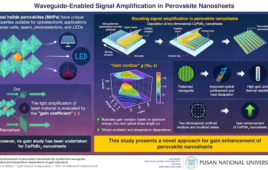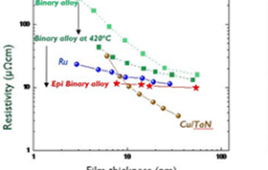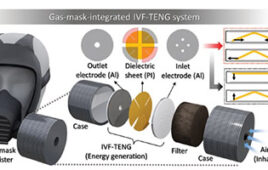Researchers at Ohio State Univ. have invented fluorescent nanoparticles that change color to tag molecules under the microscope. This series of photos shows a particle changing from red to green—and, at the 89-second mark, to yellow—over the course of two minutes. Credit: Gang Ruan, Ohio State Univ. |
Engineers at Ohio State Univ. have invented a new kind of nanoparticle that
shines in different colors to tag molecules in biomedical tests.
These tiny plastic nanoparticles are stuffed with even tinier bits of
electronics called quantum dots. Like little traffic lights, the particles glow
brightly in red, yellow, or green, so researchers can easily track molecules
under a microscope.
This is the first time anyone has created fluorescent nanoparticles that can
change colors continuously.
Jessica Winter, assistant professor of chemical and biomolecular engineering
and biomedical engineering, and research scientist Gang Ruan describe their
patent-pending technology in the online edition of Nano Letters.
Researchers routinely tag molecules with fluorescent materials in order to
see them under the microscope. Unlike the more common fluorescent molecules,
quantum dots shine very brightly, and could illuminate chemical reactions
especially well, allowing researchers to see the inner workings of living
cells.
A bottleneck to combating major diseases like cancer is the lack of
molecular or cellular-level understanding of biological processes, the
engineers explained.
“These new nanoparticles could be a great addition to the arsenal of
biomedical engineers who are trying to find the roots of diseases,” Ruan said.
“We can tailor these particles to tag particular molecules, and use the
colors to track processes that we wouldn’t otherwise be able to,” he continued.
“Also, this work could be groundbreaking for the field of nanotechnology as a
whole, because it solves two seemingly irreconcilable problems with using
quantum dots.”
Quantum dots are pieces of semiconductor that measure only a few nanometers
across. They are not visible to the naked eye, but when light shines on them,
they absorb energy and begin to glow. That’s what makes them good tags for
molecules.
Due to quantum mechanical effects, quantum dots “twinkle”—they blink on and
off at random moments. When many dots come together, however, their random
blinking is less noticeable. So, large clusters of quantum dots appear to glow
with a steady light.
Blinking has been a problem for researchers, because it breaks up the
trajectory of a moving particle or tagged molecule that they are trying to
follow. Yet, blinking is also beneficial, because when dots come together and
the blinking disappears, researchers know for certain that tagged molecules
have aggregated.
“Blinking is good and bad,” Ruan explained. “But one day we realized that we
could use the ‘good’ and avoid the ‘bad’ at the same time, by grouping a few
quantum dots of different colors together inside a micelle.”
A micelle is a nano-sized spherical container, and while micelles are useful
for laboratory experiments, they are easily found in household detergents. Ruan
created micelles using polymers, with different combinations of red and green
quantum dots inside them.
In tests, he confirmed that the micelles appeared to glow steadily. Those
stuffed with only red quantum dots glowed red, and those stuffed with green
glowed green. But those he stuffed with red and green dots alternated from red
to green to yellow.
The color change happens when one or another dot blinks inside the micelle.
When a red dot blinks off and the green blinks on, the micelle glows green.
When the green blinks off and the red blinks on, the micelle glows red. If both
are lit up, the micelle glows yellow.
The yellow color is due to our eyes’ perception of light. The process is the
same as when a red pixel and green pixel appear close together on a television
or computer screen: our eyes see yellow.
Nobody can control when color changes happen inside individual micelles. But
because the particles glow continuously, researchers can use them to track
tagged molecules continuously. They can also monitor color changes to detect
when molecules come together.
Winter and Ruan said that the particles could also be used in fluid
mechanics research—specifically, micro-fluidics. Researchers who are developing
tiny medical devices with fluid separation channels could use quantum dots to
follow the fluid’s path.
The same Ohio State research team is also developing magnetic
particles to enhance medical imaging of cancer, and it may be possible to
combine magnetism with the quantum dot technology for different kinds of
imaging. But before the particles would be safe to use in the body, they would
have to be made of biocompatible materials. Carbon-based nanomaterials are one
possible option.
In the meantime, Winter and Ruan are going to continue developing the
color-changing quantum dot particles for studies of cells and molecules under
the microscope. They are also going to explore what happens when quantum dots
of another color—for instance, blue—are added to the mix.
The university will look to license the technology for industry.





